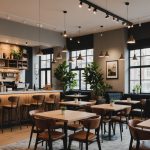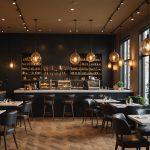Understanding the Needs of Remote Workers
Remote workers often seek cafes that blend comfort and functionality in their work environment. To create a welcoming atmosphere, understanding the key requirements of remote workers is crucial. Comfort is not just about physical luxury but encompasses ergonomic seating arrangements to cater to long hours. This includes chairs and tables designed to support good posture, essential for preventing fatigue and discomfort.
Functionality, on the other hand, involves providing key amenities such as stable Wi-Fi, abundant power outlets, and charging stations. These amenities are non-negotiable for those dependent on digital connectivity. The remote work environment should also include options for refreshments and snacks to keep energy levels up during work.
In the same genre : Elevate your café experience: unique lighting and decor strategies for a tranquil atmosphere
Insights into the work habits of remote workers reveal that flexibility in café layouts is beneficial. Remote workers often switch between tasks requiring different setups, from focused work to informal meetings. Providing varied seating arrangements and ensuring a quiet, distraction-free environment can enhance productivity and satisfaction.
Ultimately, addressing the specific needs of remote workers requires a thoughtful balance of comfort and practicality. By carefully considering these factors, cafes can become ideal havens for digital nomads seeking respite from traditional offices.
Additional reading : Sustainable soirés: how bars can maintain the party atmosphere while embracing eco-friendly practices
Interior Design Elements for a Cozy Ambiance
Designing a cozy café interior starts with careful consideration of color schemes and textures. Warm colors such as soft yellows, earthy browns, and subtle greens can lend a welcoming feel, while natural materials like wood and stone add warmth and authenticity. These elements work together to create a relaxing atmosphere conducive to focus and relaxation.
Color Schemes and Textures
Selecting the right color palette is crucial for achieving the desired ambiance. Textiles and soft furnishings in natural fibers can enhance the coziness and offer tactile comfort. Introducing varied textures can also provide visual interest and influence mood, essential for remote workers seeking an inspiring workspace.
Furniture Selection
The choice of furniture goes beyond aesthetics; ergonomic seating solutions are vital for long-term comfort. Adjustable chairs and tables support proper posture, reducing physical strain. Incorporating pieces with a blend of style and functionality ensures that the interior remains appealing yet practical.
Décor and Artwork
Integrating local art into the décor not only personalizes the space but also supports the community, adding a unique cultural element to the ambiance. Thoughtful displays of art and decorations can spark creativity and foster a sense of belonging, enriching the overall experience for patrons.
Optimizing Lighting for Productivity
Achieving optimal café lighting is essential for enhancing productivity. One commonly asked question is: How does natural light versus artificial lighting affect workspaces? According to the SQuAD method, natural light generally improves mood and alertness, which can boost productivity. However, to ensure consistent lighting throughout the day, combining natural and artificial sources is often necessary.
Well-considered choices of lighting types can augment workspace environments. Task lighting, such as desk lamps, focuses on specific work areas, allowing workers to dedicate attention with minimal eye strain. Ambient lighting, which provides general illumination, ensures no dark spots distract from tasks. Accent lighting subtly enhances the atmosphere, making the space more inviting.
An important aspect is the adjustable lighting options; they cater to varying personal preferences and tasks. Dimmable lights can be beneficial for transitioning between concentration and relaxation modes, adjusting to the natural circadian rhythms of remote workers.
Implementing a thoughtful mix of these lighting considerations will make café environments more accommodating and functional, ultimately supporting the diverse needs of remote workers aiming for efficiency and comfort.
Creating a Comfortable Layout
A well-designed café layout significantly impacts the effectiveness of a remote work environment. Zoning the space for different activities is crucial. Workspaces should be clearly defined to accommodate focused tasks, group collaborations, and relaxing breaks. Dedicated zones with appropriate furniture cater to diverse needs, enhancing both comfort and productivity.
Zoning for Different Activities
Distinct areas facilitate varied workstyles. Incorporating quiet nooks for concentration, flexible seating for interactive meetings, and communal tables for informal collaborations helps remote workers adapt their environment to specific tasks. Consider creating a blend of open and private spaces to meet different work preferences.
Minimizing Distractions
Noise control is paramount in a productive workspace. Strategies like soundproofing walls and using screens or partitions can effectively minimize disruptions. Integrating plants and soft furnishings can also absorb sound, contributing to a quieter, more serene atmosphere essential for maintaining focus.
Privacy Considerations
Providing a degree of privacy in communal settings is important for remote workers. Partitions and private nooks allow individuals to work without feeling exposed, fostering a sense of security. This thoughtful arrangement not only respects personal space but also enhances the overall atmosphere, making the café a welcoming and efficient workplace.
Essential Amenities for Remote Workers
Creating a remote work environment that meets the needs of workers primarily hinges on specific café amenities. Reliable Wi-Fi access is one of the most critical components, as it allows uninterrupted connection for digital tasks and communication. Without stable internet, productivity can significantly decline.
In addition to connectivity, the availability of power outlets and charging stations supports the continuous use of electronic devices. Remote workers often appreciate easily accessible power sources, as they help prevent the inconvenience of dead batteries and lost work.
Moreover, offering refreshments and snacks can elevate the working experience. Having options for coffee, tea, and light bites can keep energy levels steady, enabling workers to sustain focus over extended periods. It’s not just about providing sustenance but fostering an environment where remote workers feel catered to and valued.
By integrating these amenities, cafes can transform into hubs that cater to the modern work lifestyle. With a few thoughtful adjustments, a café can provide all the essentials for a productive and pleasant workday, proving to be an ideal location for remote work.
Successful Café Transformations
Transforming a café into a haven for remote workers requires a strategic blend of design and functionality. Successful café transformations inspire others to follow suit by showcasing measurable benefits post-redesign. Through before and after comparisons, cafes can illustrate the tangible changes brought about by design improvements.
Before and After Comparisons
Comparisons highlight the enhancements in seating arrangements, lighting, and amenities, demonstrating their impact on attracting clientele. For example, a café might emphasize how ergonomic seating and improved lighting doubled the time customers choose to stay and work.
Customer Testimonials
Another critical aspect is customer testimonials, which often reveal insights into how changes affect the remote work atmosphere. Feedback from patrons can underscore improved workflow efficiency and satisfaction derived from amenities like increased power outlets and refreshed décor.
Lessons Learned
Key lessons learned from transformations involve balancing aesthetics with practicality. Cafes have found that providing adaptable spaces and maintaining a consistent theme can significantly boost user experience. Emphasizing how such changes fostered community inclusion and attracted more digital nomads can serve as a blueprint for future endeavors. A well-planned transformation can redefine a café’s appeal and utility for remote workers.
Attracting Remote Workers Through Marketing
Engaging remote workers requires effective café marketing strategies that highlight your location’s unique attributes. Leveraging social media is an efficient way to showcase your space’s ambiance and facilities. Visual content, such as images and videos of your café environment, can attract remote workers by providing a sneak peek into its atmosphere. Posting regularly can maintain interest and reach a broader audience.
Hosting community events is another potent strategy that not only attracts digital nomads but also fosters a sense of belonging. Events like skill-sharing workshops or networking meet-ups can draw remote workers seeking social interaction outside their home offices. These gatherings help cultivate a vibrant, engaged community centered around your café.
Furthermore, establishing collaborations with local businesses and influencers can amplify your marketing efforts. Partnering with nearby companies for joint promotions or featuring local influencers in your content can enhance your visibility. These collaborations introduce your café to their networks, potentially driving more foot traffic.
By focusing on these innovative marketing strategies, your café can become a preferred destination for remote workers, providing not just a workspace but a dynamic community hub.











